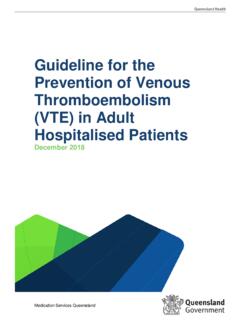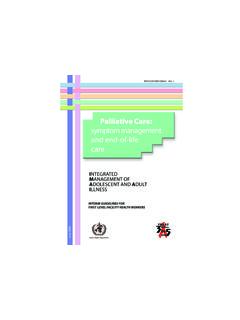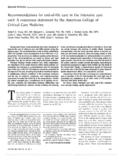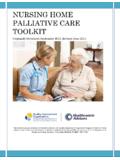Transcription of Guidelines for Subcutaneous Infusion Device …
1 E-mail: Web: EditionFunded by the Australian GovernmentDepartment of Health and AgeingGuidelines forSubcutaneous InfusionDevice Managementin palliative CareCentre for palliative CareResearch and EducationQueensland HealthFirst published in 2006 as Guidelines for syringe driver management in palliative care . Reprinted 2007 Second edition 2010 COPYRIGHT STATEMENT The State of Queensland, Queensland Health, 2010 Copyright protects this publication. However, Queensland Health has no objection to this material being reproduced with acknowledgment, except for commercial purposes.
2 Permission to reproduce for commercial purposes should be sought from the Policy and Quality Officer, Queensland Health, GPO Box 48, Brisbane Q. 4001. ISBN 978-1-921707-07-0 Printed by Herston Multimedia Unit E-mail: Web: for palliative CareResearch and EducationHMMU Nov 10 1287 Griffin_jkE-mail: Web: EditionFunded by the Australian GovernmentDepartment of Health and AgeingGuidelines forSubcutaneous InfusionDevice Managementin palliative CareCentre for palliative CareResearch and EducationQueensland HealthFirst published in 2006 as Guidelines for syringe driver management in palliative care .
3 Reprinted 2007 Second edition 2010 COPYRIGHT STATEMENT The State of Queensland, Queensland Health, 2010 Copyright protects this publication. However, Queensland Health has no objection to this material being reproduced with acknowledgment, except for commercial purposes. Permission to reproduce for commercial purposes should be sought from the Policy and Quality Officer, Queensland Health, GPO Box 48, Brisbane Q. 4001. ISBN 978-1-921707-07-0 Printed by Herston Multimedia Unit E-mail: Web: for palliative CareResearch and EducationHMMU Nov 10 1287 Griffin_jk1 Guidelines for Subcutaneous Infusion Device Managementin palliative care - Second EditionRevised by:John HaberechtResearch Officer, Centre for palliative care Research and EducationOriginally developed by:Victoria J.
4 KainProject Officer, Centre for palliative care Research and EducationProfessor Patsy YatesActing Director, Centre for palliative care Research and Education;and Queensland University of TechnologyRevised in consultation with:Linda BarrettNurse Unit Manager, Metro South palliative care Service (Brisbane South)Toni BradleyNurse Unit Manager, palliative care Service, The Prince Charles HospitalKerri DooleyProject Manager, Spiritus care Services, BrisbaneAnthony HallSenior Lecturer, School of Pharmacy, Griffith UniversityProfessor Janet HardyDirector of palliative care , Mater Health Services, BrisbaneKaren MitchellProject/Research Officer, Congress of Aboriginal and Torres Strait Islander NursesSally PikeNurse Unit Manager, Royal Brisbane and Women s Hospital palliative care ServiceJennifer RowePalliative care Coordinator.
5 Community and Allied Health, Roma HospitalJill SandersClinical Nurse, KarunaGeorgi SladeEducator, St Vincent s BrisbaneAssoc Prof Rohan VoraMedical Director, palliative care Services, Gold Coast Hospital2 ContentsAims and One The patient Two Equipment Guidelines and Three The selection, preparation and maintenance of the Four Drugs and Five Patient/family education Six - Patient assessment and troubleshooting A Levels of B Literature C Commonly used DisclaimerThe information within these Guidelines is presented by the Centre for palliative care Research and Education (CPCRE)
6 For the purpose of disseminating health information free of charge and for the benefit of the healthcare CPCRE has exercised due care in ensuring the accuracy of the material contained within these Guidelines , the document is a general guide only to appropriate practice, to be followed subject to the clinician s judgement and the patient s preference in each individual does not accept any liability for any injury, loss or damage incurred by use of or reliance on the information provided within these Guidelines are intended to provide clinicians and palliative care services with Guidelines to inform practice, the development of policy and procedures, and associated training and education programs in relation to portable Subcutaneous Infusion Device One.
7 Literature Review & Development of Clinical Practice GuidelinesThis revised edition of the The Guidelines for Subcutaneous Infusion Device Management in palliative care takes account of the October 2007 withdrawal from sale in Australia of the Graseby syringe driver, a Subcutaneous Infusion Device that was the major focus of the first edition. Information about possible alternatives to the Graseby is offered in this document, as well as on the palliative care Australia1 and CPCRE2 websites. However because the Graseby syringe driver is still widely used, information relevant to that Device will continue to be included in this should be noted that the Graseby Device was withdrawn from the market in a context of concern regarding the level of user error.
8 Many services have now purchased alternative devices . Also important in the Graseby s removal from sale was the Therapeutic Goods Administration s aim of having Australia align with international best practice regarding the licensing and use of medical devices . While the distributors of the Graseby within Australia are required by law to continue to service it until October 2012, it is not known whether they will continue to do so beyond that date. For all these reasons, continued use of Graseby devices could be literature review was undertaken in 2009 to identify current evidence regarding Subcutaneous Infusion Device management and update the previous review.
9 1 2 CINAHL and PubMed databases were searched for the purposes of the review (CINAHL, Medline, PsycArticles and PsycInfo were searched for the original review). The review of the literature was again limited to adult patients and the English language, and covered a ten year period from 1999-2009 (original review 1995-2005). Search terms originally included: syringe drivers, Subcutaneous infusions, end-of-life care , Graseby and palliative care . For the 2009 review, the original search terms were used as well as: Alaris AD; Niki T34; McKinley T34; and CADD.
10 The Alaris AD has since been withdrawn from the Australian market. An internet search using the Google search engine was also undertaken using the same search terms. This identified relevant websites relating to syringe driver literature was rated for its level of evidence using the Joanna Briggs Levels of Evidence chart (Appendix A). All abstracts identified during the search were assessed by two reviewers, and articles were retrieved for all papers that were identified by the project officer as being of relevance to the review addition, clinical notes, websites and books about Subcutaneous Infusion devicesidentified as relevant to the project were examined.

















